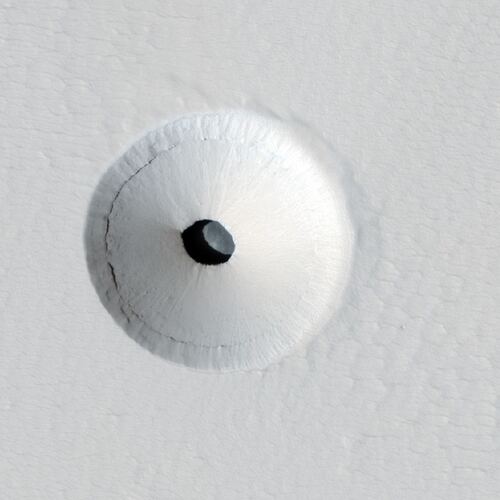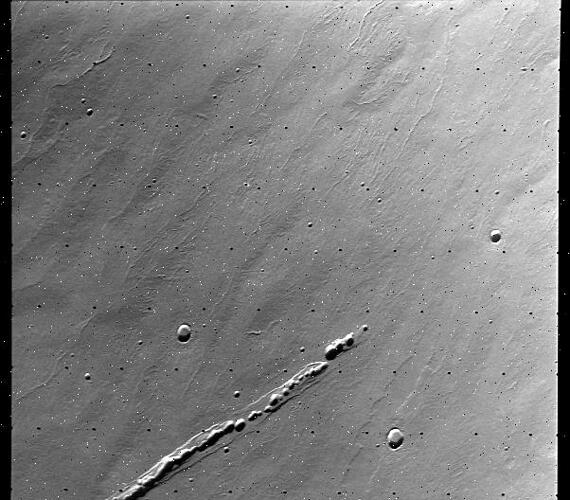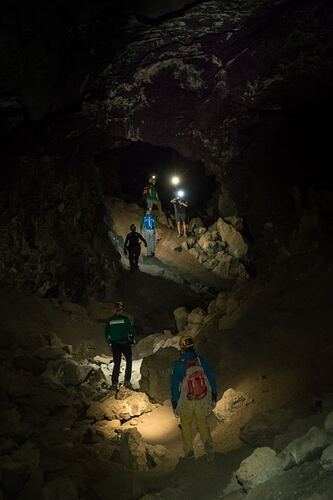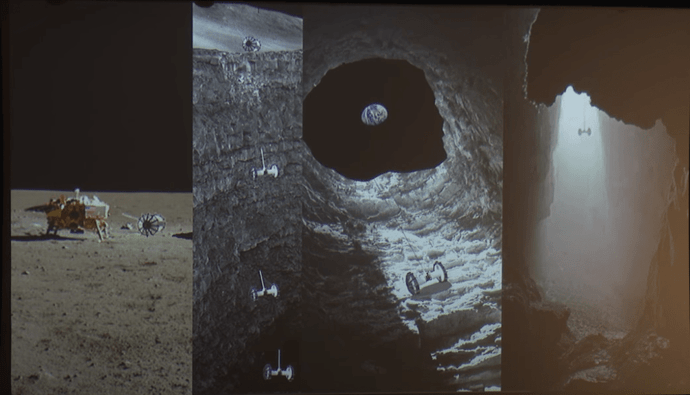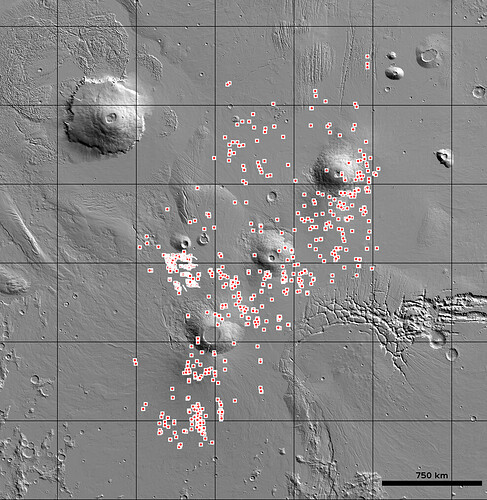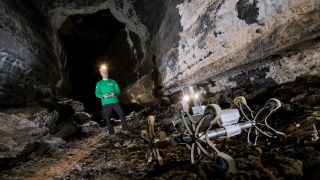List members , it's official now - even mainstream science has declared underground Lava tubes on our Moon and on Mars as the best potential sites to build a base . Interestingly , Earth too has many such Lava tubes...hmm :))
Lava Tubes on the Moon and Mars are Really, Really Big. Big Enough to Fit an Entire Planetary Base
Could lava tubes on the Moon and Mars play a role in establishing a human presence on those worlds? Possibly, according to a team of researchers. Their new study shows that lunar and Martian lava tubes might be enormous, and easily large enough to accommodate a base.
Both the Moon and Mars were volcanically active at one time, and all that activity has left its mark on both worlds. Mars hosts the largest volcano in the Solar System, Olympus Mons, as well as numerous lava tubes. The Moon has no volcanoes, but orbiters have spotted lava tubes on the surface. And those tubes are attracting more and more attention, as future plans for a habitat of some sort on both worlds are taking shape.
A team of researchers from Italian universities have completed a new study into these tubes. Its title is “Lava tubes on Earth, Moon and Mars: A review on their size and morphology revealed by comparative planetology.” The lead author is Riccardo Pozzobon, a planetary geologist at the Department of Geosciences of the University of Padua. The study is published in the journal Earth-Science Reviews.
The evidence for lava tubes—or pyroducts—on Mars and the Moon is in the form of long sinuous raised channels, and in so-called “sky-lights,” where the roof of a lava tube has caved in. There are lots of orbiter images of these features, though unfortunately they haven’t been explored yet.
This is a cropped version of a HiRISE image of a lava tube skylight on the martian volcano Pavonis Mons. Image Credit: By NASA / Jet Propulsion Laboratory / University of Arizona – http://hirise.lpl.arizona.edu/ESP_023531_1840, Public Domain, File:Pavonis Mons lava tube skylight crop.jpg - Wikimedia Commons
In their paper, the authors write that “On the Moon subsurface cavities have been inferred from several skylights in Maria smooth plains and corroborated using gravimetry and radar sounder, while on Mars several deep skylights have been identified on lava flows with striking similarities with terrestrial cases.”
“We can find lava tubes on planet Earth, but also on the subsurface of the Moon and Mars according to the high-resolution pictures of lava tubes’ skylights taken by interplanetary probes. Evidence of lava tubes was often inferred by observing linear cavities and sinuous collapse chains where the galleries cracked”, explained co-author Francesco Sauro in a press release.
Spectacular high Sun view of the Mare Tranquillitatis pit crater revealing boulders on an otherwise smooth floor. The 100 meter pit may provide access to a lunar lava tube. Image Credit: By NASA/GSFC/Arizona State University – http://photojournal.jpl.nasa.gov/catalog/PIA13518, Public Domain, File:Mare Tranquillitatis pit crater.jpg - Wikimedia Commons
To try to better understand them, the authors of the new paper created an overview of lava tubes on Earth, then compared them to data from Mars and the Moon.
“These collapse chains represent ideal gateways or windows for subsurface exploration. The morphological surface expression of lava tubes on Mars and the Moon is similar to their terrestrial counterpart. Speleologists thoroughly studied lava tubes on Earth in Hawaii, Canary Islands, Australia and Iceland,” Sauro said.
An image of a lava tube on Mars’ Alba Mons, from NASA’s Viking Orbiter. Image Credit: NASA
Lava tubes are formed by flowing lava. As the outside of the flowing lava cools and hardens, it forms a tube through which liquid lava flows. That lava can drain out of the tube, leaving a hollow structure that can travel for a long way, and be very voluminous. On Earth, the longest lava tube is the Kazamura Cave in Hawaii. It’s 65.5 km (40.7 mi) long. Sometimes they’re apparent from linear pit chains on the surface which are connected linearly underground.
There’s a key difference between lava tubes on Earth and other places, though. On Earth, lava tubes and their skylights form from volcanic activity. But on the Moon and Mars, some tubes and skylights can form from impact melt and other processes. “Likewise,” the authors write, “on the Moon not all skylights formed in volcanic terrains, but also in impact melts, therefore in these cases other processes are probably responsible for their formation. For these reasons, any study aiming to identify lava tube collapses and skylight candidates on the surface of these planetary bodies has to follow a rigorous approach based on a geomorphological comparison with terrestrial analogues.”
This figure from the study shows the main morphological and morphometric characters of tectonic pit chains on Mars (l) and on the Moon (r). For more info, see the study. Image Credit: Pozzobon et al, 2020.
The authors wanted a way to quantify lunar and Martian lava tubes, and to understand their morphology. Though we’ve never explored these tubes on either world, there’s lots of orbital data available. That was key to this study.
“We measured the size and gathered the morphology of lunar and Martian collapse chains (collapsed lava tubes), using digital terrain models (DTMs), which we obtained through satellite stereoscopic images and laser altimetry taken by interplanetary probes”, said Riccardo Pozzobon. “We then compared these data to topographic studies about similar collapse chains on the Earth’s surface and to laser scans of the inside of lava tubes in Lanzarote and the Galapagos. These data allowed us to establish a restriction to the relationship between collapse chains and subsurface cavities that are still intact.”
What they found was that Earthly lava tubes pale in comparison to their lunar and Martian counterparts. Earthly tubes have diameters in the 10 to 100 meter (33 to 330 ft) range. But Martian tubes are about 100 times wider than that, and lunar tubes are positively gargantuan in comparison: 1000 times wider. The difference is due to the lower gravity on both worlds, and its effect on volcanism.
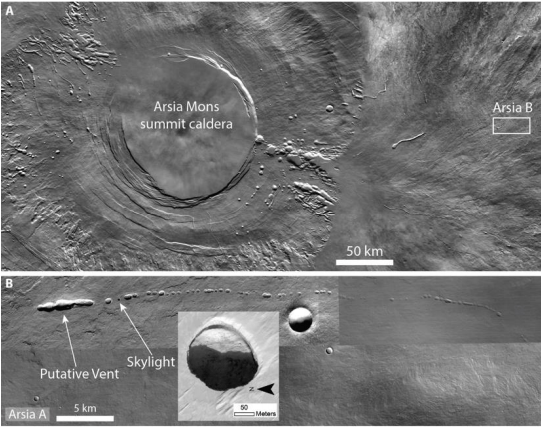
This figure from the study shows some tubes, vents, and skylights on the Arsia Mons volcano on Mars. Lava tubes on Mars can be 100 times wider than on Earth, according to the study. Image Credit: Pozzobon et al, 2020.
“Tubes as wide as these can be longer than 40 kilometres, making the Moon an extraordinary target for subsurface exploration and potential settlement in the wide protected and stable environments of lava tubes,” Pozzobon said. “The latter are so big they can contain Padua’s entire city centre.”
But are they stable environments? Many orbital pictures show collapsed lava tubes, with skylights dotting the tubes. According to Matteo Massironi, they are stable, thanks to the lower gravity, and impacts are to blame for the collapses and skylights.
“What is most important is that, despite the impressive dimension of the lunar tubes, they remain well within the roof stability threshold because of a lower gravitational attraction,” explains Matteo Massironi, who is professor of Structural and Planetary Geology at the Department of Geosciences of the University of Padua. “This means that the majority of lava tubes underneath the maria smooth plains are intact. The collapse chains we observed might have been caused by asteroids piercing the tube walls. This is what the collapse chains in Marius Hills seem to suggest. From the latter, we can get access to these huge underground cavities.”
These huge underground areas would solve some of the problems associated with habitats on Mars and the Moon. At the top of the list is radiation. While Earth’s atmosphere and magnetosphere keep life on Earth mostly safe from radiation, the same isn’t true for the Moon or for Mars. Long-term exposure to all that radiation is a significant cancer risk.
But a habitat under all that rock would be well-protected from both cosmic radiation and solar radiation. It would also be safe from micrometeorites, another hazard that has to be contended with. The temperature would also be more stable. And on Mars, the tubes and caves could possibly provide a viable habitat for any life that might exist on that planet. After all, here on Earth caves and lava tubes are a specialized habitat that provides shelter for adapted organisms.
Lava tubes on Earth and Mars. On the left is Australia’s Undara Lava Tube, and on the right is a Martian lava tube at Arsia Mons. Image Credit: Pozzobon et al, 2020.
“Lava tubes could provide stable shields from cosmic and solar radiation and micrometeorite impacts which are often happening on the surfaces of planetary bodies,” said co-author Francesco Sauro. “Moreover, they have great potential for providing an environment in which temperatures do not vary from day- to night-time. Space agencies are now interested in planetary caves and lava tubes, as they represent a first step towards future explorations of the lunar surface (see also NASA’s project Artemis) and towards finding life (past or present) in Mars subsurface.”
But before talk of bases and habitats in lava tubes heats up too much, it’s worth keeping mind that we haven’t seen inside one yet. And while Earthly lava tubes have been explored, we just don’t know how close the comparison will really be. So it’s time for one of the space agencies to prioritize that in their mission planning and selection.
Astronauts with the ESA have already done some lava tube exploring here on Earth as part of their training. In 2016, ESA astronauts Luca Parmitano and Pedro Duque explored lava tubes and caves in Spain’s Canary Islands. These landscapes are used because they’re thought to be very similar to Mars.
ESA astronauts exploring lava caves and tubes in Spain as part of their training. Image Credit: ESA–M. Barnabei
The ESA also put out the word that they’d like to hear proposals for lunar lava tube exploration.
“In autumn 2019, ESA called up universities and industries with a campaign seeking ideas for developing technologies for lunar caves exploration. They are specifically looking for systems that would land on the lunar surface to operate missions exploring lunar tubes,” said Unibo professor Jo De Waele, who is one of the authors of this study and a speleologist.
“Since 2012, in collaboration with some European universities including Bologna and Padua, ESA has been carrying out two training programmes for astronauts focusing on the exploration of underground systems (CAVES) and planetary geology (PANGAEA). These programmes include lava tubes on the island of Lanzarote. So far, 36 astronauts from five space agencies have received training in cave hiking; moreover, six astronauts and four mission and operation specialists have received geological field training.”
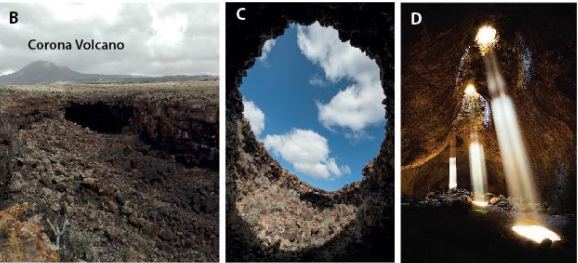
The Corona Volcano on Lanzarote in the Canary Islands. It features lava tubes and skylights that mimic conditions on Mars. Image Credit: Pozzobon et al, 2020.
It might be considered overly-ambitious to send astronauts into lunar lava caves. They’re specialized environments even here on Earth. If there were any accidents, an injured astronaut in a cave on the Moon would be a very delicate situation.
Over on the NASA side of things, scientists are considering robotic exploration. NASA scientists have proposed the “Moon Diver” mission. It would use a rover tethered to a lander to explore lava tubes on the Moon. The lander would land in proximity to a skylight, then the tethered rover would be deployed to climb its way down to the floor of the tube.
Four panels from a video presentation on the Moon Diver concept. Image Credit: KISSCaltech
A mission to explore lava tubes on Mars is likely a long, long way off. But if one is ever developed, it won’t have a shortage of targets. The United States Geological Service says that there are over 1,000 candidate cave entrances on Mars.
This is a map of lave cave candidates in the post-volcanic Tharsis Region on Mars. Image Credit: USGS/Mars Global Cave Candidate Catalog.
It’s clear that space agencies have set their sights on lava tubes. A lunar habitat might be years or decades away, but it seems likely that we’ll build one. And when we do, it’ll take a special kind of human to live in an underground lava tube on another world.
Regards

